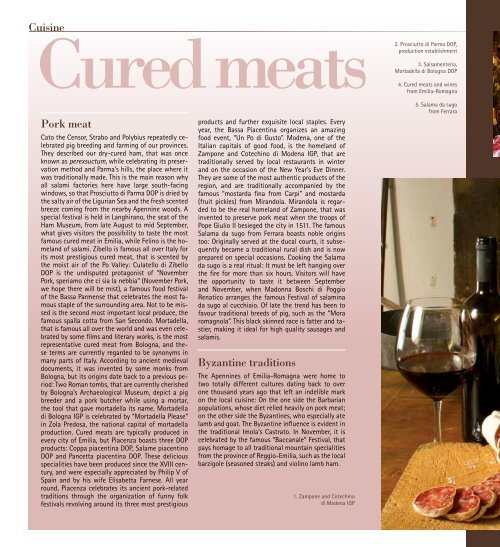of Emilia Romagna
of Emilia Romagna
of Emilia Romagna
Create successful ePaper yourself
Turn your PDF publications into a flip-book with our unique Google optimized e-Paper software.
Cuisine<br />
Cured meats<br />
2. Prosciutto di Parma DOP,<br />
production establishment<br />
3. Salsamenteria,<br />
Mortadella di Bologna DOP<br />
4. Cured meats and wines<br />
from <strong>Emilia</strong>-<strong>Romagna</strong><br />
Pork meat<br />
Cato the Censor, Strabo and Polybius repeatedly celebrated<br />
pig breeding and farming <strong>of</strong> our provinces.<br />
They described our dry-cured ham, that was once<br />
known as perexsuctum, while celebrating its preservation<br />
method and Parma’s hills, the place where it<br />
was traditionally made. This is the main reason why<br />
all salami factories here have large south-facing<br />
windows, so that Prosciutto di Parma DOP is dried by<br />
the salty air <strong>of</strong> the Ligurian Sea and the fresh scented<br />
breeze coming from the nearby Apennine woods. A<br />
special festival is held in Langhirano, the seat <strong>of</strong> the<br />
Ham Museum, from late August to mid September,<br />
what gives visitors the possibility to taste the most<br />
famous cured meat in <strong>Emilia</strong>, while Felino is the homeland<br />
<strong>of</strong> salami. Zibello is famous all over Italy for<br />
its most prestigious cured meat, that is scented by<br />
the moist air <strong>of</strong> the Po Valley: Culatello di Zibello<br />
DOP is the undisputed protagonist <strong>of</strong> “November<br />
Pork, speriamo che ci sia la nebbia” (November Pork,<br />
we hope there will be mist), a famous food festival<br />
<strong>of</strong> the Bassa Parmense that celebrates the most famous<br />
staple <strong>of</strong> the surrounding area. Not to be missed<br />
is the second most important local produce, the<br />
famous spalla cotta from San Secondo. Mortadella,<br />
that is famous all over the world and was even celebrated<br />
by some films and literary works, is the most<br />
representative cured meat from Bologna, and these<br />
terms are currently regarded to be synonyms in<br />
many parts <strong>of</strong> Italy. According to ancient medieval<br />
documents, it was invented by some monks from<br />
Bologna, but its origins date back to a previous period:<br />
Two Roman tombs, that are currently cherished<br />
by Bologna’s Archaeological Museum, depict a pig<br />
breeder and a pork butcher while using a mortar,<br />
the tool that gave mortadella its name. Mortadella<br />
di Bologna IGP is celebrated by “Mortadella Please”<br />
in Zola Predosa, the national capital <strong>of</strong> mortadella<br />
production. Cured meats are typically produced in<br />
every city <strong>of</strong> <strong>Emilia</strong>, but Piacenza boasts three DOP<br />
products: Coppa piacentina DOP, Salame piacentino<br />
DOP and Pancetta piacentina DOP. These delicious<br />
specialities have been produced since the XVIII century,<br />
and were especially appreciated by Philip V <strong>of</strong><br />
Spain and by his wife Elisabetta Farnese. All year<br />
round, Piacenza celebrates its ancient pork-related<br />
traditions through the organization <strong>of</strong> funny folk<br />
festivals revolving around its three most prestigious<br />
products and further exquisite local staples. Every<br />
year, the Bassa Piacentina organizes an amazing<br />
food event, “Un Po di Gusto”. Modena, one <strong>of</strong> the<br />
Italian capitals <strong>of</strong> good food, is the homeland <strong>of</strong><br />
Zampone and Cotechino di Modena IGP, that are<br />
traditionally served by local restaurants in winter<br />
and on the occasion <strong>of</strong> the New Year’s Eve Dinner.<br />
They are some <strong>of</strong> the most authentic products <strong>of</strong> the<br />
region, and are traditionally accompanied by the<br />
famous “mostarda fina from Carpi” and mostarda<br />
(fruit pickles) from Mirandola. Mirandola is regarded<br />
to be the real homeland <strong>of</strong> Zampone, that was<br />
invented to preserve pork meat when the troops <strong>of</strong><br />
Pope Giulio II besieged the city in 1511. The famous<br />
Salama da sugo from Ferrara boasts noble origins<br />
too: Originally served at the ducal courts, it subsequently<br />
became a traditional rural dish and is now<br />
prepared on special occasions. Cooking the Salama<br />
da sugo is a real ritual: It must be left hanging over<br />
the fire for more than six hours. Visitors will have<br />
the opportunity to taste it between September<br />
and November, when Madonna Boschi di Poggio<br />
Renatico arranges the famous Festival <strong>of</strong> salamina<br />
da sugo al cucchiaio. Of late the trend has been to<br />
favour traditional breeds <strong>of</strong> pig, such as the “Mora<br />
romagnola”. This black skinned race is fatter and tastier,<br />
making it ideal for high quality sausages and<br />
salamis.<br />
Byzantine traditions<br />
The Apennines <strong>of</strong> <strong>Emilia</strong>-<strong>Romagna</strong> were home to<br />
two totally different cultures dating back to over<br />
one thousand years ago that left an indelible mark<br />
on the local cuisine: On the one side the Barbarian<br />
populations, whose diet relied heavily on pork meat;<br />
on the other side the Byzantines, who especially ate<br />
lamb and goat. The Byzantine influence is evident in<br />
the traditional Imola’s Castrato. In November, it is<br />
celebrated by the famous “Baccanale” Festival, that<br />
pays homage to all traditional mountain specialities<br />
from the province <strong>of</strong> Reggio-<strong>Emilia</strong>, such as the local<br />
barzigole (seasoned steaks) and violino lamb ham.<br />
1. Zampone and Cotechino<br />
di Modena IGP<br />
5. Salama da sugo<br />
from Ferrara
















